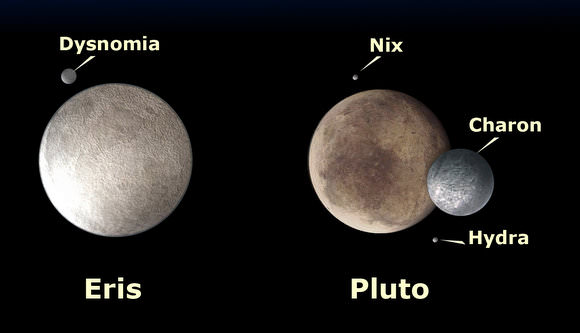[/caption]
Or two dwarf planets in the Kuiper Belt…
Eris — that pesky big dwarf planet that caused all the brouhaha about planets, dwarf planets, plutoids and the like — has gotten a closer look by a team of astronomers from several different universities, and guess what? Eris and Pluto have a lot in common. Eris appears to have a frozen surface, predominantly covered in nitrogen ice and methane, just like Pluto.
The scientists integrated two years of work conducted in Northern Arizona University’s new ice research laboratory, in addition to astronomical observations of Eris from the Multiple Mirror Telescope Observatory from Mount Hopkins, Ariz., and of Pluto from Steward Observatory from Kitt Peak, Ariz.
“There are only a handful of such labs doing this kind of work in the world,” said Stephen Tegler, from NAU and lead author of “Methane and Nitrogen Abundances on Eris and Pluto,” which was presented this week at the American Astronomical Society’s Divison of Planetary Science meeting. “By studying surfaces of icy dwarf planets, we hope to get a better understanding of the processes that affect their surfaces.”
NAU’s ice lab grew optically clear ice samples of methane, nitrogen, argon, methane-nitrogen mixtures, and methane-argon mixtures in a vacuum chamber at temperatures as low as minus 390 degrees Fahrenheit to simulate the planets’ cold surfaces. Light passed through the samples revealed the “chemical fingerprints” of molecules and atoms, which were compared to telescopic observations of sunlight reflected from the surfaces of Eris and Pluto.
“By combining the astronomical data and laboratory data, we found about 90 percent of Eris’s icy surface is made up of nitrogen ice and about 10 percent is made up of methane ice, which is not all that different from Pluto,” said David Cornelison, coauthor and physicist at Missouri State University.
The scientists say the recent findings will directly enhance NASA’s New Horizons spacecraft mission, currently scheduled to fly by Pluto in 2015, by lending greater value to the continued research of Eris and Pluto.
Source: Northern Arizona University, DPS


Both Pluto and Eris are planets, and it is time for sites like this to stop portraying one side in an ongoing debate as fact when this is not the case. Dr. Alan Stern, who coined the term “dwarf planet,” intended it to refer to a subclass of planets large enough to be in hydrostatic equilibrium (pulled into a round shape by their own gravity) but not large enough to gravitationally dominate their orbits. He never intended dwarf planets to be designated as not planets at all. Notably, the IAU demotion of Pluto, done by only four percent of its members, most of whom are not planetary scientists, has been opposed by an equal number of professional astronomers in a formal petition.
As dynamic worlds with geology and weather, Pluto and Eris show they have more in common with the other, bigger planets than they do with most Kuiper Belt Objects except the few large ones, which should be considered planets too. Most KBOs in Pluto’s and Eris’ orbital path are tiny and do not have these features. This data shows that before making definitive classifications, we should first get the data and analyze it; otherwise, we are defining objects without knowing significant factors about them.
There might be a gaggle of these dwarf planets out there. These little bodies might hold evidence of the chemistry of the accretion disk cloud which the solar system formed from.
LC
There may be grumbling, but there is no on-going debate. Pluto and Eris are not planets: they are dwarf planets. These are no more planets than asteroids are planets.